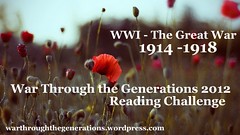An Intimate History of the First World War
Author: Peter EnglundTranslator: Peter Graves
Publisher-Format: Knopf, Epub,560 pages
Year of publication: 2011
Subject: World War I
Setting: Eastern Front, Alps, Balkans, east Africa, Mesopotamia, Paris
Genre: History, letters and diaries
Source: owned - purchased for Nook
Recommended? ABSOLUTELY
As a participant in the War Through the Generations 2012 Reading Challenge, I've been immersing myself in books set before, during and immediately after The Great War. In the non-fiction realm, I began with Barbara Tuchman's epic The Guns of August where we could see the major players - politicians and generals who drew up and "executed" the war plans.
This is not a book to be enjoyed in the sense of bringing pleasure or smiles to the reader, but it is a book to be savored and remembered and celebrated. In this work, the author gives us the Great War, not as a series of battles, blunders, and victories, not as the bloviations of politicians, kings, tsars, potentates and generals, not as compilations of maps, charts, statistics, and bureaucratic mumblings; rather he gives us the people who fought, lived and died this war. These are the people who had to carry out the ill-fated plans and decisions of the higher-ups. He gives us their hopes and dreams, their frustrations, their fears, their boredom and hunger, their cold and wet, or hot and arid (but always hungry) lives that resulted from the bureaucratic and autocratic decisions made miles and worlds away. We are given poverty - not of spirit or money, but of supplies, medicines, machines, ammunition, food, basic shelter, and even the simple tools needed to bury their dead. At the same time, we are given soaring and enriching insights into the resilience of the human spirit and the hopefulness that can exist in spite of such dire situations.
We mutter at the vast spread in treatment of POWs - from nightly card games and decent food served in the "officer's mess", to brutal marches and confinements with little or no food, water or sanitation. We gasp, we wipe away tears, we sit back to draw deep breaths because to read this is to feel, and to realize how little comprehension we have of what the real experience of the war was. We begin to see how little the individuals involved knew about "the big picture."
In trying to explain the breath-taking and stunning impact of this book, I found myself again and again returning to the list of Dramatis Personnae (and their delightful pictures)- there are twenty of them, male and female. The youngest and oldest were females--a 12 year old German school girl) and a 49 year old Scottish aid worker); in between, there are other women and men who represent almost every country participating in the war - Germany, Belgium, France, Great Britain, Australia, the US, New Zealand, Italy (including an Italian American who returned to Europe to fight for the fatherland), Russia, an American woman married to a Polish aristocrat living in Poland, a Dane serving in the German army, and a Venezuelan soldier of fortune in the Ottoman army. They were infantrymen, cavalrymen, ambulance drivers, civil servants, civilians trapped in a world of diminishing food and shelter, alpine climbers, fighter pilots, well-diggers, telecommunications linemen, artillerymen, field surgeons, nurses, officers, enlisted, POWs--all of them at the mercy of their superiors--all of them ignorant of what was happening anyplace but where they stood. Englund draws on diaries, letters, and other original source materials in many languages to bring us their first person observations.
A note about the author: (p 503)
Peter Englund is a Swedish historian, who has received numerous prizes in his own country and whose words have been translated into fifteen languages. He has been working as a war correspondent in the Balkans, Afghanistan, and Iraq. Englund is a member of the Swedish Academy (which awards the Nobel Prize in Literature) and in 2008 was appointed its new permanent secretary, an office he still holds.
In his introduction, Englund tells us better than I would even attempt to what this book is and isn't:
To the Reader: (pg. 9-11)
As a historian, I have often longed to be present where and when events happen, but...I discovered ...to be right in the middle of events is no guarantee of being able to understand them. You are stuck in a confusing, chaotic and noisy reality and the chances are that the editorial office on the other side of the planet often has a better idea of what is going on than you do--just as a historian, paradoxically enough, often has a better understanding of an event than those who were actually involved in it.
...This is a book about the First World War. It is not, however, a book about what it was--that is, about its causes, course, conclusion and consequences--but a book about what it was like. In this volume the reader will meet not so much factors, as people, not so much events and processes as feelings, impressions, experiences and moods.
.....I wanted to depict the war as an individual experience, to go beyond the usual historical and sociological categories, and also beyond the usual narrative forms in which, at best, people such as these appear as no more than tiny specks of light, flickering by in the grand historical sweep....an attempt to deconstruct this utterly epoch-making event into its smallest, most basic component--the individual, and his or her experiences.
As a historian, and as a writer, he has succeeded beyond anything we have a right to expect.









You're right that it's a book to be savored! I liked that it was different from other non-fiction accounts of WWI. Great review!
ReplyDelete